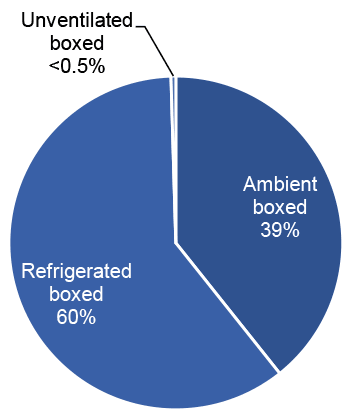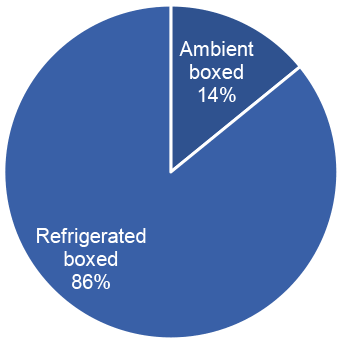Pesticide usage in Scotland: arable crops and potato stores 2020
This publication presents information from a survey of pesticide use on arable crops and potato stores in Scotland during 2020.
This document is part of a collection
2020 Potato storage and pesticide usage
Seed potatoes
- An estimated 391,208 tonnes of seed potatoes were stored in Scotland in 2020, compared with an estimated 312,793 tonnes stored in 2018 (calculated using new survey methodology)
- Sixty per cent of seed potatoes were stored in refrigerated stores, 39 per cent in ambient ventilated stores and less than one per cent in unventilated stores (Figure 5)
- All seed potatoes sampled in 2020 were stored in boxes
- Overall, 39 per cent of seed potatoes received a pesticide treatment in store
- The percentage of seed potatoes receiving an in-store pesticide treatment was 41 per cent in ambient ventilated stores and 37 per cent in refrigerated stores. No treatments were recorded on unventilated stores (Table 1)
- Two fungicides (imazalil and thiabendazole) were encountered in seed potatoes (summary below)
- Imazalil and thiabendazole are applied as sprays to tubers.
- Reasons for use were supplied for 81 per cent of the crop which was treated with fungicides. Twenty-five per cent for dry rot, 23 per cent for unidentified storage diseases 14 per cent for gangrene, 13 per cent for skin spot and six per cent for silver scurf
Summary of estimated pesticide use on seed potatoes in store:
| Pesticide formulation | Total tonnes treated | % Treated |
|---|---|---|
| Imazalil | 149,138 | 38 |
| Thiabendazole | 17,041 | 4 |

Ware potatoes
- An estimated 596,407 tonnes of ware potatoes were stored in Scotland in 2020. This is a six per cent increase compared with the estimated 562,894 tonnes stored in 2018 (calculated using new survey methodology)
- Eighty-six per cent of ware potatoes were stored in refrigerated stores and 14 per cent were stored in ambient ventilated stores. No ware potatoes were encountered during the 2020 survey in unventilated stores (Figure 6)
- All ware potatoes sampled were stored in boxes
- Six per cent of ware potatoes received a pesticide treatment in store
- The percentage of ware potatoes receiving an in-store pesticide treatment was six and one per cent in refrigerated stores and ambient ventilated stores respectively (Table 1)
- Two fungicides (thiabendazole & imazalil) and two growth regulators (ethylene & spearmint oil) were encountered in ware potato stores (summary below)
- Thiabendazole and imazalil are applied as a spray to tubers. Ethylene is applied as a gas, and spearmint oil is applied as a fog to stores.
- Reasons for use were supplied for five per cent of the crop which was treated with fungicides. Three per cent for dry rot and two per cent for general disease control
- The only specified reason for use of growth regulators was sprout suppression
Summary of estimated pesticide use on ware potatoes in store:
| Pesticide formulation | Total tonnes treated | % Treated |
|---|---|---|
| Ethylene | 24,497 | 4 |
| Imazalil(1) | 2,617 | 0.4 |
| Spearmint oil | 9,704 | 2 |
| Thiabendazole | 8 | 0.001 |
(1) This formulation is not approved on ware potatoes. It was applied to
seed crops which were later reclassified as ware.

Contact
Email: psu@sasa.gov.scot
There is a problem
Thanks for your feedback